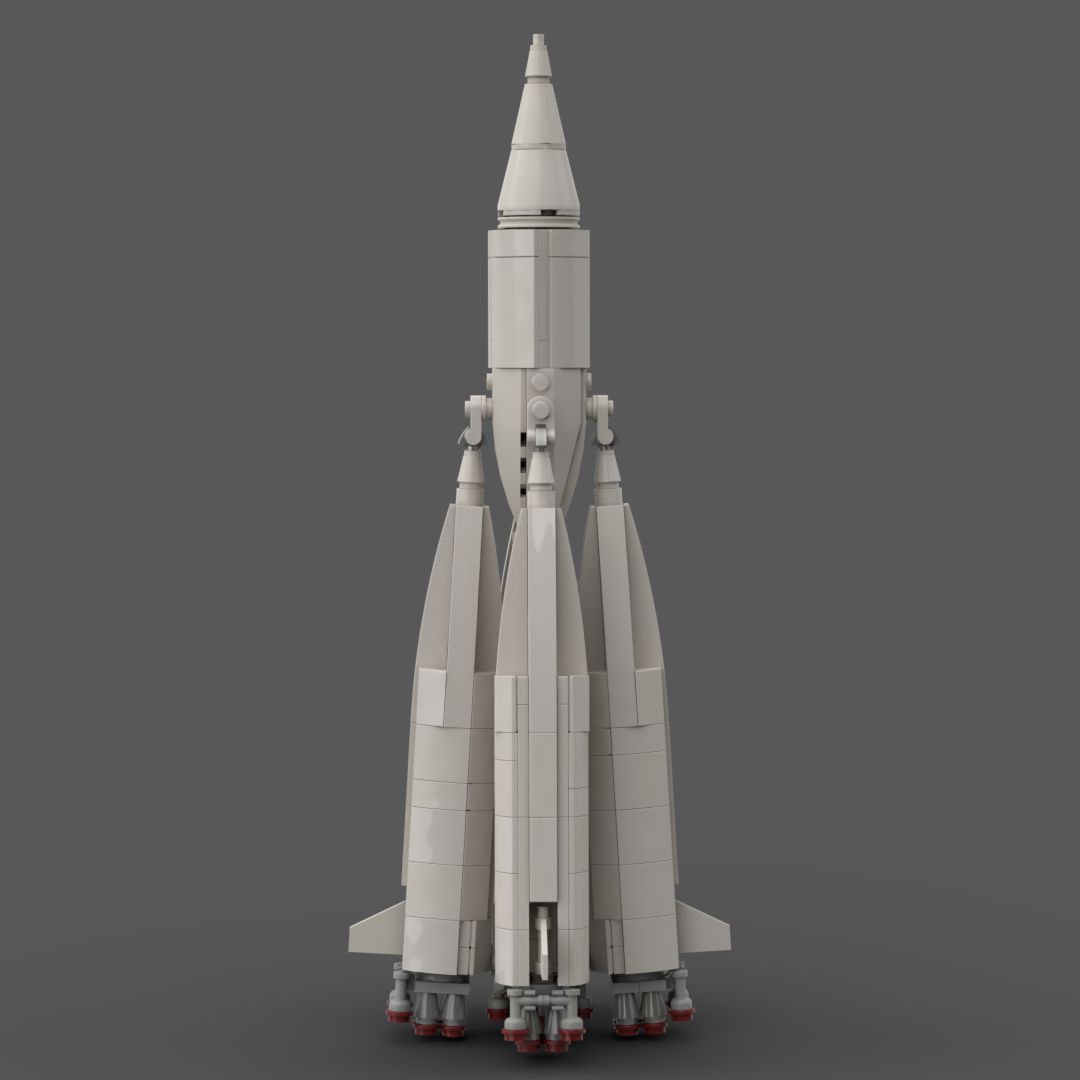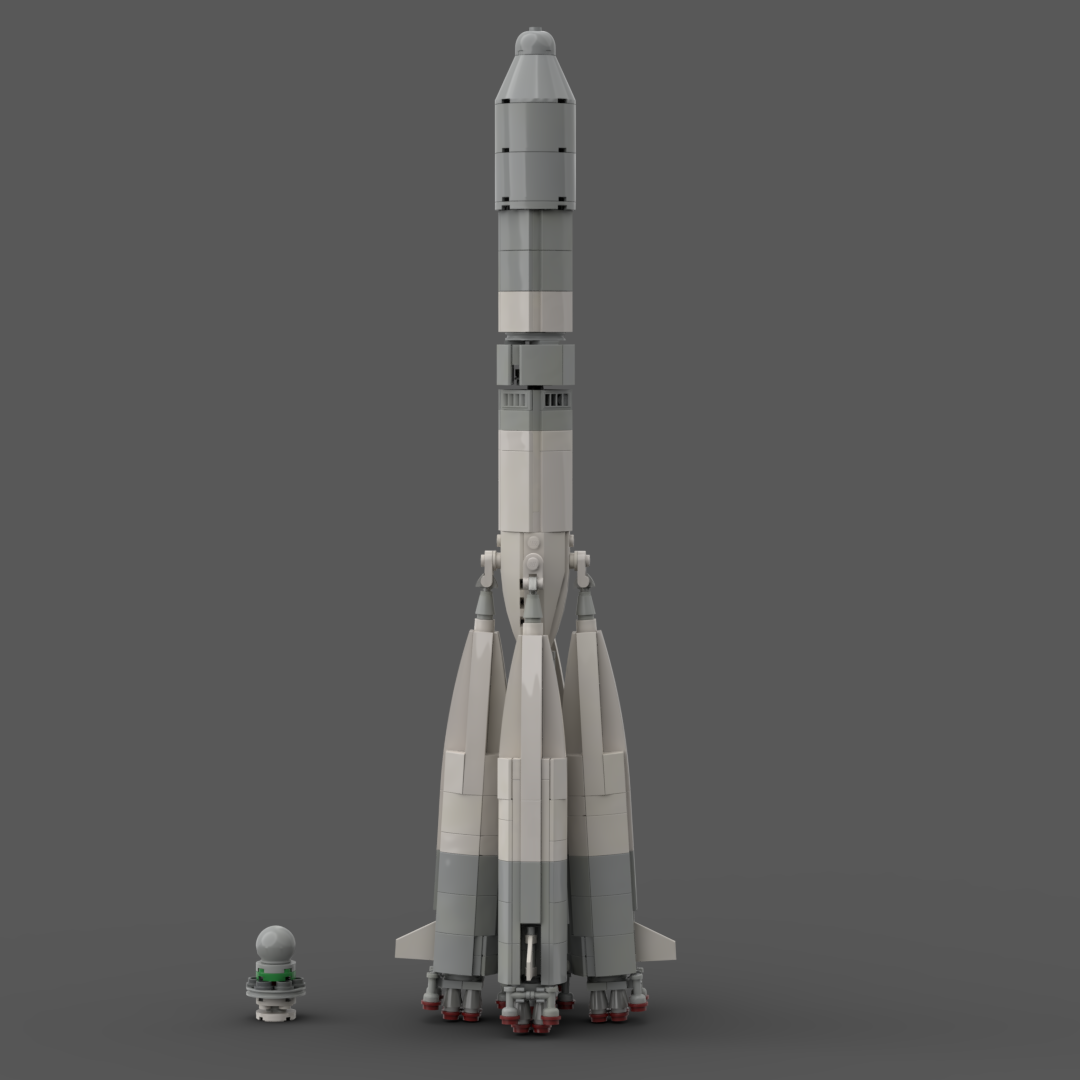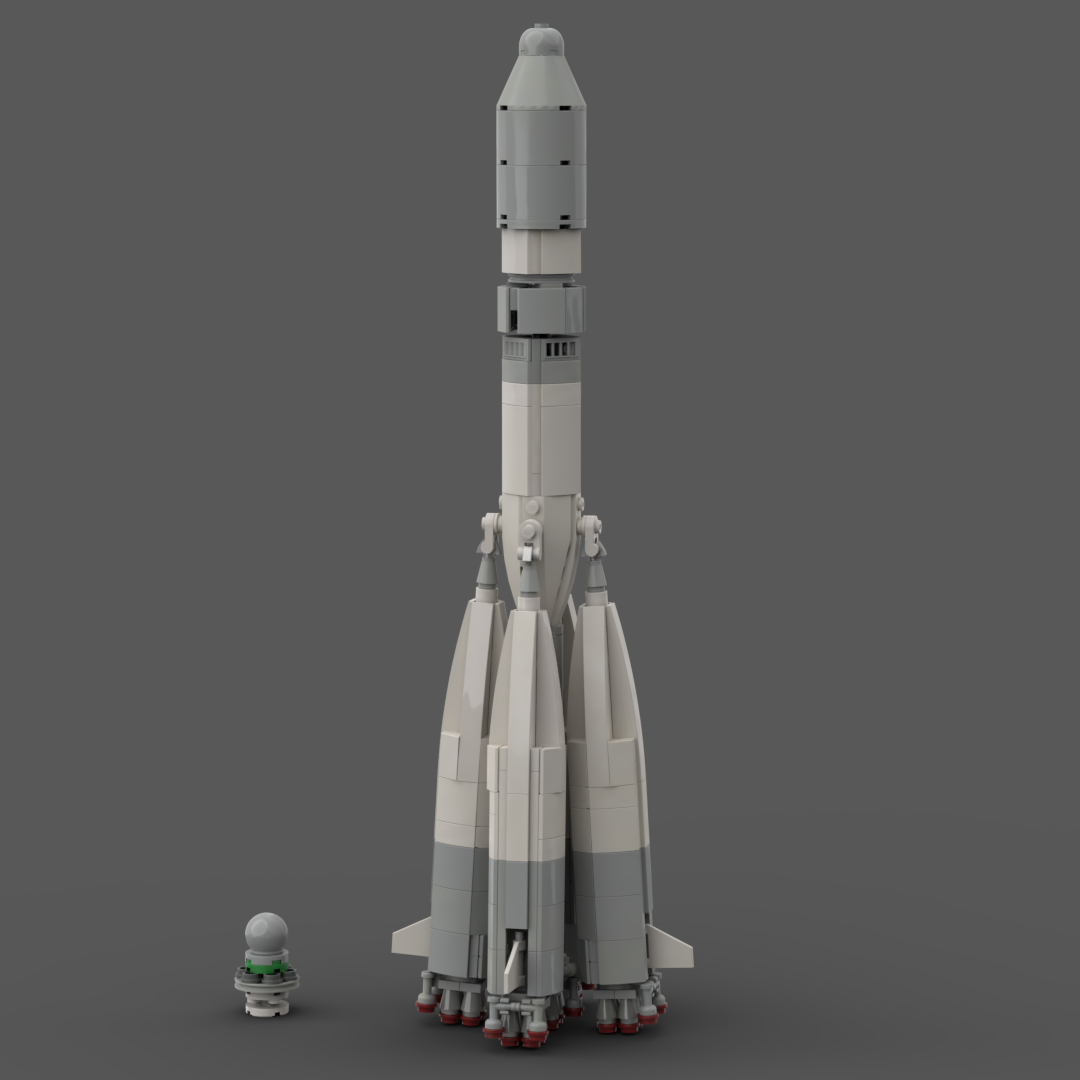
LEGO Designer:
Sam Bradford (0 Gravity Bricks)
Designed:
June 2020
Categories:
Launch Vehicles, All, Small Lift Launch Vehicles, Space Agency - Roscosmos
Launch Vehicle Details
Stages:
Length:
Diameter:
Mass at Launch:
Low Earth Orbit Capacity:
Total Thrust:
Apogee:
Class:
R-7 Sputnik 1 (8K71PS M1-1PS)
The version of the R-7 rocket that was destined to carry the first satellite into orbit was designated 8K71PS M1-1PS. It was a modified version of the R-7 Semyorka (8K71), the worlds first Intercontinental Ballistic Missile. M1-1PS had it’s military warhead removed, as well as measurement hardware, the top avionics section containing the vibration monitoring system, cables connecting the rocket and the warhead and a considerable portion of the flight control hardware, including the radio-control system. Some of the onboard electric batteries were also removed. As a result, the total mass of the rocket went down from 280 tons for the original R-7 rocket to 267 tons, at the time of liftoff for the space launcher. At liftoff, the engines would reach the total thrust of around 398 tons.
Upon reaching the orbit, the main engine cutoff had to be performed by the gyroscopic integrator or on a command from the emergency contact of the turbine in the main engine. Such command would be issued as soon as the rocket run out of fuel or oxidizer.
All tracking of the rocket in flight had to be conducted passively by means of radar, without onboard response, and with the help of ground telescopes. Both ways had a limited range and accuracy. Based on experience with the previous launch of the R-7 rocket, ground controllers expected the binocular tracking system to “see” no further than 200 kilometers for the rocket, and much less for a satellite. In the meantime, the P-30 radar demonstrated an effective range of 500 kilometers, when tracking aircraft. Its effectiveness would be further reduced by a relatively slow rotation of its antenna. Optical sensors Kth-41 and KT-50 available in Tyuratam at the time had a range of 100-200 kilometers, also too short for effective tracking of a satellite.
Sputnik 1
Sputnik 1 was the first artificial Earth satellite. The Soviet Union launched it into an elliptical low Earth orbit on 4 October 1957. It orbited for three weeks before its batteries died and then silently for two more months before it fell back into the atmosphere. It was 58 cm (23 in) in diameter and a polished metal sphere with four external radio antennas to broadcast radio pulses. Its radio signal was easily detectable by radio amateurs, and the 65° inclination and duration of its orbit made its flight path cover virtually the entire inhabited Earth. The satellite’s unanticipated success triggered the Space Race. The launch was the beginning of a new era of political, military, technological and scientific developments.
R-7 Sputnik 2 (8K71PS M1-2PS)
For the launch of the second satellite, the second braking nozzle was added to the core stage of the rocket to prevent tumbling of the vehicle upon entering orbit. As in the rocket launching the first satellite, the braking nozzle would employ gas, which pressurized oxidizer tank during the powered flight.
Once in orbit, a special programming device, installed on the core stage would switch the Tral-Ts telemetry system from transmitting the parameters of the rocket to channel data from scientific payloads.
To help maintain proper temperature in the dog cabin, the transfer cone, which connected the satellite with the rocket, was thoroughly polished, additional thermal blanket were added and copper panels were installed on the telemetry boxes. The core stage was also equipped with deployable reflectors.
To maximize scientific payload of Sputnik-2, some flight control equipment was removed from the rocket. For the same purpose, the flight profile was modified to ensure maximum use of onboard propellant. It was achieved by programming the flight control system to shut down the main engine only when its turbo pump detects that it run out of either propellant or oxidizer. In the previous launch, this way of shutting down the engine was only a backup mode.
Sputnik 2
Sputnik 2 was the second spacecraft launched into Earth orbit, on 3 November 1957, and the first to carry a living animal, a Soviet space dog named Laika. Laika died on the fourth orbit due to overheating caused by an air conditioning malfunction.
During the first two orbits, it proved difficult to reliably track Sputnik 2’s flight path, but ground controllers were able to intercept theodolite data from an American tracking station in Perth, Australia. Data showed that Laika’s heart rate and breathing spiked rapidly during ascent, but she otherwise reached orbit largely unscathed. Official Soviet press releases stated that Laika survived a week in orbit, but information released in the post-Soviet era indicated that she died only a few hours into the mission. Other sources suggested it had been four days before the dog succumbed to overheating and carbon dioxide buildup.
Telemetry data indicated that Laika’s vital signs were normal for the first three orbits, but during the fourth orbit, the cabin temperature rose to 43 °C (109 °F) followed by movements of the dog. Data received on the second day showed no signs of breathing, heart rate, or blood pressure, but the cardio sensor was still registering a heart beat. By the morning of 6 November, there were no signs of life in the capsule. On 10 November, the batteries in the spacecraft ran out and all data transmission ceased, after 150 separate telemetry sessions. Sputnik 2 reentered the atmosphere on 14 April 1958 after 162 days in space and about 2500 orbits. Reentry was sighted from the east coast of the United States and surviving debris impacted in the Amazon region of South America.
Designer Notes
Part count: 497 bricks, 48 lots.
| Unit | width | length | height |
|---|---|---|---|
| Studs | 14.4 | 14.4 | 36.8 |
| Centimetres | 11.5 | 11.5 | 29.4 |
| Inches | 4.5 | 4.5 | 11.6 |
Downloads
Pay what you feel
This digital model is provided free of charge. However, if you like it, and you would like to thank the designer for their time, please consider a donation of your choice. 100% of your donation will go directly to the designer.
Donations can be made by following this link:
Part count: 497 bricks, 48 lots.
| Unit | width | length | height |
|---|---|---|---|
| Studs | 14.4 | 14.4 | 36.8 |
| Inches | 4.5 | 4.5 | 11.6 |
| Centimetres | 11.5 | 11.5 | 29.4 |
No external URL provided.
Launch History information from space.skyrocket.de
Launch History information from space.skyrocket.de



